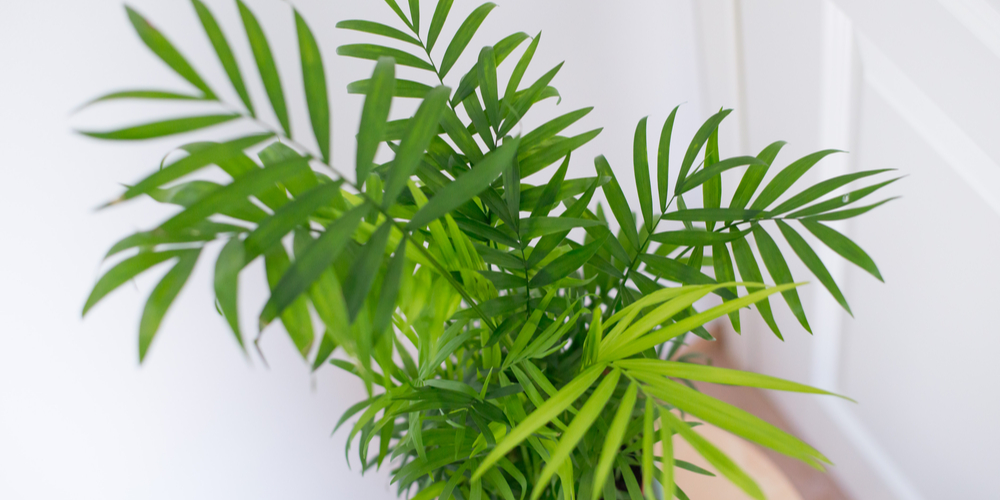If you are looking for an air purifying houseplant, you should consider getting a Neanthe Bella Palm for your interiors. This tropical plant isn’t particularly challenging to grow and will adapt to most indoor environments. Neanthe Bella Palm is an attractive species that even beginner gardeners can appreciate.
And if you want to learn more about this plant, you have landed in the right place! Keep reading this essential guide to have all the knowledge you need to grow a thriving Neanthe Bella Palm at home!
| Botanical Name | Chamaedorea elegans |
| Common Name | Neanthe Bella Palm or Parlor Palm |
| Plant Type | Perennial |
| Flower Color | When mature, a Neanthe Bella Palm will flower even as a houseplant. Its blooms are yellow, tiny, and rise above the foliage on tall stalks. |
| Size When Mature | Between 2 and 6 feet tall and up to 3 feet wide. |
| Bloom Time | Not applicable |
| Sun Requirements | Bright Indirect Light |
| USDA Hardiness Zones | 10-12 |
| Soil PH Range | Between 5.1 and 7.5 |
| Soil Type | Well-draining and rich |
| Water Needs | Medium |
| Native Area | Southern Mexico and Guatemala |
What you Need to Know About Neanthe Bella Palm
If you like palms and want to add a tropical touch to your interiors, you’ll fall in love with the Neanthe Bella Palm. This versatile plant is relatively easy to grow but also attractive and long-living.
Under the ideal growing conditions, your plant will display lush foliage with light green fronds that will add texture and volume to your interiors. Also, this palm is safe for animals and humans. So, you won’t have to worry too much about your pets or kids curiously sniffing (and maybe munching) it.
How to Care for Neanthe Bella Palm
Despite being a low-maintenance plant, you still have to know about its needs and requirements to have a thriving palm at home. And, don’t worry: you’ll find all the information you need in the following sections!
Light
The best thing about Neanthe Bella’s palms is that they adapt to most light conditions. For this reason, many people choose to grow them in their offices, where they might not have the best lighting.
These plants will perform best in bright rooms with plenty of indirect sunlight. Consider adding shears if you feel the sun hitting the window too strongly. But if you can’t offer such conditions, don’t worry: these palms will also adapt to shady situations. However, you’ll have to rotate your plant to ensure an even growth pattern.
Also, avoid exposing it to direct sunlight, as it will burn its leaves!
Water and Soil Needs
When growing houseplants, you’ll have to pay attention to the soil you pick. The Neanthe Bella Palm performs well in most conditions but prefers rich and well-draining substrates. You can use a peat-based potting mix for best results. Also, consider amending the soil to keep the pH levels between 5.1 and 7.5: your palm will thank you!
You should keep the soil moist but not soggy: avoid leaving the substrate dry for too long, but don’t overwater it. Adapt your watering schedule to your local climate conditions and allow the water to seep out of the pot’s drainage hole to give it enough moisture. Usually, adding water every 7 to 10 days will give your plant all it needs.
Temperature Requirements
You should only grow this plant outside if you live in USDA hardiness zones between 10 and 12. After all, the Neanthe Bella Palm is a tropical plant with little resistance to the cold. Indoors, keep it at temperatures between 65 and 80°F and avoid exposing it to conditions below 60°F for too long. Also, move it away from drafts of hot or cold air.
Mist your palm at least once a week to increase humidity, and consider adding a pebble tray. While your plant might do well even in drier environments, it will grow much better in relatively moist conditions.
Fertilizer
You will have to add an all-purpose fertilizer during the spring and summer to support your Neanthe Bella Palm. Use the high-quality product and apply it at half strength once a month. Don’t forget to follow the instructions you find on the product label to avoid burning your plant.
Common Diseases
Despite being resistant to most pests and diseases, your plant might have an issue with red spider mites. So, keep an eye on them and ensure you provide your plant with all it needs to better react to attacks.
Also, avoid overwatering: it will cause root rotting and eventually kill your palm tree!


